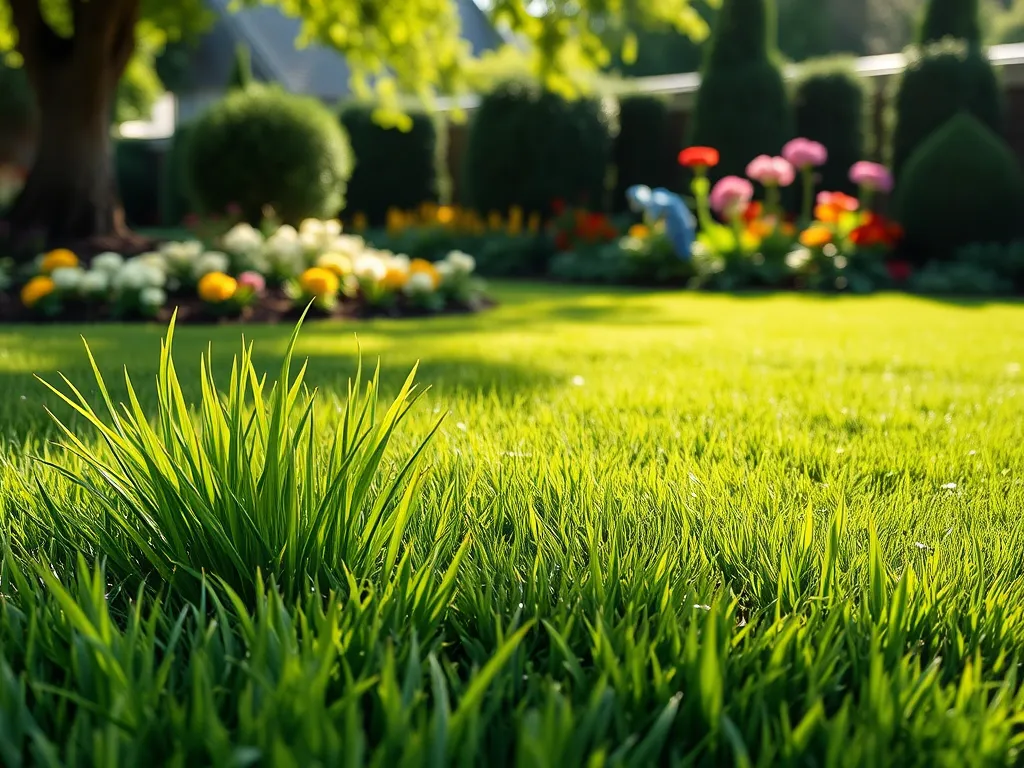Understanding the Importance of Cutting Height for Healthy Lawns

The Ultimate Guide to Lawn Care
Lawn care is an essential aspect of maintaining a beautiful and healthy yard. A well-cared-for lawn not only enhances the aesthetic appeal of your home but also contributes to the overall health of the environment by improving air quality and providing habitat for wildlife. With the right lawn care practices, homeowners can achieve a lush green lawn that is resilient to pests and diseases while also being environmentally friendly.
Understanding the various grass health factors can significantly enhance your lawn's vibrancy and resilience.
Effective lawn care involves understanding the specific needs of your grass type, soil conditions, and climate. From proper watering techniques to the right mowing practices, every aspect of lawn care plays a critical role in the longevity and health of your grass. Establishing a consistent lawn care routine can prevent common issues such as weeds, pests, and diseases, ensuring your lawn remains vibrant and thriving throughout the seasons.
One of the fundamental practices of lawn care is maintaining the right cutting height for your grass. Cutting grass too low can lead to several problems, including reduced root growth and increased vulnerability to pests and diseases. Therefore, knowing the optimal cutting height for your specific grass type, along with seasonal adjustments, can significantly improve your lawn’s health.
In addition to cutting height, the techniques used during mowing also affect the overall health of your lawn. Varying mowing patterns, using sharp blades, and mowing at the right frequency can all contribute to a healthier lawn. By avoiding common mistakes in mowing, such as cutting too low or not maintaining equipment properly, you can ensure a lush, green yard.
Maintaining the optimal mowing height ensures your grass remains healthy and encourages deeper root development.
Lastly, choosing the right tools for lawn care is crucial. From selecting the appropriate mower to regularly maintaining your equipment, investing in quality tools can enhance your lawn care efforts. Additionally, new technologies and innovative mowing tools can provide precision and ease in maintaining your lawn.
Optimal Cutting Height
Determining the ideal cutting height for different grass types is vital for healthy lawn care. For example, Bermuda grass typically thrives when cut between 1 to 2 inches high, while Kentucky bluegrass prefers heights of 2 to 3 inches. Knowing your specific grass type and its optimal height can significantly influence your lawn's aesthetic and health.
Cutting height affects lawn health by influencing how much sunlight and moisture the grass can absorb. Taller grass blades can shade the soil, reducing weed growth and conserving moisture. On the other hand, cutting too low exposes the soil to stress, making it easier for weeds and pests to take root.
Seasonal adjustments to cutting height are necessary to adapt to the changing weather conditions. During hotter months, it’s advisable to raise the mowing height to help the grass retain moisture. Conversely, during cooler periods, lowering the height can aid in promoting healthier growth by allowing more sunlight to reach the grass.
Implementing effective lawn appearance tips can transform your outdoor space, making it the envy of the neighborhood.
Benefits of Proper Cutting Height
Maintaining the correct cutting height has a direct impact on grass growth and density. Taller grass tends to have deeper roots, allowing it to absorb more nutrients and withstand drought conditions. Furthermore, consistent cutting encourages denser turf, which reduces bare patches and creates a more attractive lawn.
Proper cutting height also helps in reducing the number of weeds and pests. The shade from taller grass blades inhibits weed germination, while healthier grass is more resilient and better equipped to fend off pests. Thus, maintaining the right height serves as a natural form of pest control.
Enhancing drought resistance is another significant benefit of cutting to the proper height. Grass that is allowed to grow taller has a better chance of surviving dry spells, as the longer blades contain more moisture and reduce evaporation from the soil. This not only contributes to a healthier lawn but also conserves water during dry periods.
Cutting Techniques
Employing specific mowing patterns that benefit lawn health is an essential technique in lawn care. Changing patterns can prevent soil compaction and ensure that grass grows evenly. For instance, mowing in a different direction each time can help reduce wear patterns caused by consistent cutting in one direction.
Using sharp blades for a clean cut is crucial. Dull blades can tear the grass rather than cutting it cleanly, leading to uneven growth and making the lawn more susceptible to disease. Regularly sharpening mower blades can lead to a healthier lawn and facilitate better recovery after mowing.
The frequency of mowing should be adapted based on the cutting height. It's generally recommended to mow once a week during the growing season, but this may vary depending on the growth rate of your grass. Ensuring that you only cut one-third of the grass blade in a single mowing session can help to maintain optimal grass health.
Tools for Lawn Cutting
Choosing the right mower for your lawn size is essential for effective lawn care. For small to medium lawns, a push mower may suffice, while larger areas may require a riding mower. Electric mowers are also a great option for eco-conscious homeowners, often providing quieter operation with less environmental impact.
Maintaining lawn mowers is crucial for their longevity and performance. Regularly checking oil levels, cleaning the undercarriage, and inspecting the blades can help ensure that your mower operates efficiently and effectively. Proper maintenance of mowing equipment can save you from repair costs and improve the quality of your lawn care efforts.
Innovative cutting tools for precision, such as robotic mowers or advanced mulching mowers, can greatly enhance your lawn care routine. These tools offer precision cutting abilities and can even operate autonomously, saving you time and effort while ensuring a healthy and well-maintained lawn.
Common Mistakes in Mowing
One of the most significant effects of mowing too low is the stress it places on grass, making it more susceptible to pests and diseases. Shorter grass has less photosynthesis capability and can weaken the root system, leading to long-term damage that can be costly to remedy.
Frequency of mowing errors often occurs when homeowners either mow too frequently or too infrequently. Mowing too frequently can stress the grass, while infrequent mowing can result in overgrowth, leading to uneven cuts and potential lawn damage.
Misconceptions about lawn cutting height can lead to poor lawn care practices. Many people believe that cutting grass lower will result in less frequent mowing, which is counterproductive as it can create more problems than it solves. It's crucial to educate oneself about grass types and proper height maintenance to ensure a healthy lawn.
